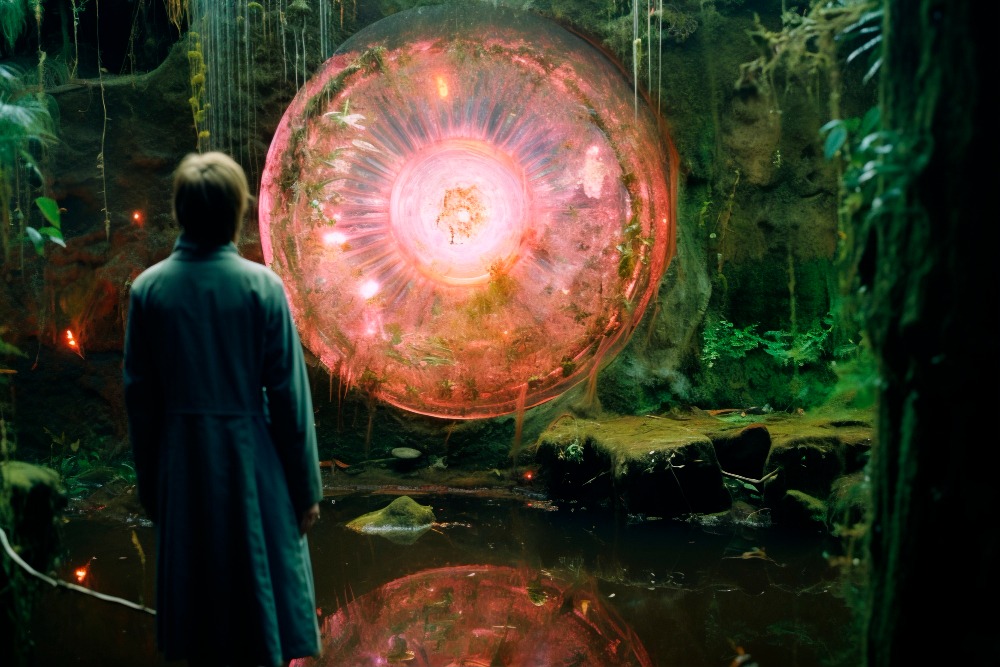Have you ever gazed upon the night sky and wondered if we’re alone in the universe? The vastness of space ignites imaginations, and the search for extraterrestrial intelligence (SETI) has captivated humanity for decades. One intriguing concept in the search for alien civilizations is the Dyson Sphere – a hypothetical megastructure built around a star to capture its energy. But in 2024, have we stumbled upon actual evidence of these celestial engineering marvels? Let’s embark on a cosmic journey to explore the theory of Dyson Spheres, delve into recent astronomical discoveries, and separate scientific fact from captivating speculation.
A Beacon in the Cosmos: The Allure of Dyson Spheres
The concept of Dyson Spheres first emerged in the 1960s, proposed by physicist Freeman Dyson. These hypothetical megastructures would be colossal artificial constructs encompassing a star, essentially creating a giant solar collector. The purpose of such a structure? To harness the immense energy output of a star, potentially powering an advanced alien civilization.
The Dyson Sphere Spectrum: A Range of Possibilities
The original Dyson Sphere concept proposes a complete shell surrounding a star. However, variations on this theme exist:
- Swarm Dyson Spheres: A multitude of orbiting satellites or habitats could collectively capture a star’s energy, achieving a similar function to a solid shell.
- ** Dyson Shells:** These hypothetical structures would be positioned at a specific distance from a star to capture its energy within a habitable zone, potentially allowing for the existence of life on the inner surface.
The Elusive Hunt: Searching for Signs of Extraterrestrial Intelligence
The vast distances between stars and the limitations of current technology make directly detecting alien civilizations a monumental challenge. However, astronomers are exploring various methods to search for potential signs of extraterrestrial intelligence (SETI):
- Searching for Radio Signals: SETI initiatives use powerful radio telescopes to scan the cosmos for potential artificial radio signals that could be sent by alien civilizations.
- Exoplanet Exploration: Discovering Earth-like planets within the habitable zones of stars is a key focus. The existence of such planets could increase the chances of finding life elsewhere in the universe.
- Unusual Starlight Patterns:A Dyson Sphere could potentially cause a star’s brightness to dim periodically as different sections of the sphere move between Earth and the star.
- Infrared Signatures:The immense heat generated by a Dyson Sphere might leave a telltale infrared signature detectable by telescopes.
- Spectral Analysis:Anomalies in a star’s light spectrum, caused by the materials used to construct a Dyson Sphere, could offer clues.
2024: A Year of Cosmic Discoveries?
As of October 2024, there haven’t been any confirmed discoveries of Dyson Spheres. However, exciting developments in astronomy keep the search alive:
- Breakthrough Telescopes: New and powerful telescopes like the James Webb Space Telescope are pushing the boundaries of astronomical observation, potentially offering a clearer view of distant stars and their environments.
- Advanced Data Analysis Techniques: Machine learning and artificial intelligence are being used to analyze vast amounts of astronomical data, potentially aiding in the detection of unusual stellar phenomena.
- Citizen Science Projects: Initiatives like SETI@Home allow the public to contribute to the search for extraterrestrial intelligence by analyzing radio telescope data.
Beyond the Hype: The Challenges of Detecting Dyson Spheres
The search for Dyson Spheres faces significant challenges:
- The Immensity of Space: The sheer distances between stars make it difficult to detect faint anomalies that could indicate a Dyson Sphere’s presence.
- Technological Limitations: Current observational capabilities might not be sensitive enough to definitively detect Dyson Spheres, especially if they are very distant or employ advanced cloaking technologies.
- Distinguishing Natural Phenomena: Certain natural phenomena like dust clouds or stellar activity can mimic some of the potential signs of Dyson Spheres, making confirmation difficult.
A World Built Around a Star – The Science Behind Dyson Spheres
Dyson Spheres capture our imagination, but scientific considerations shed light on their feasibility and potential drawbacks:
Engineering Challenges: Building a Stellar Shell
Constructing a Dyson Sphere presents immense engineering hurdles:
- Material Strength: The structure would need to withstand unimaginable heat and radiation from the star it surrounds. Developing materials capable of such feats is beyond our current technological capabilities.
- Maintaining Stability: A Dyson Sphere would need to be incredibly strong and stable to withstand the immense gravitational forces and potential stellar flares.
- Energy for Construction: The sheer amount of energy required to construct such a megastructure is mind-boggling. Even advanced alien civilizations might face challenges in acquiring the necessary resources.
The Energy Problem: A Balancing Act
While a Dyson Sphere could potentially capture a vast amount of stellar energy, challenges remain:
- Heat Dissipation: The immense heat generated by the captured energy would need to be efficiently dissipated to avoid overheating the structure.
- Energy Distribution: Distributing the captured energy throughout the vast sphere in a controlled and usable manner would be a complex engineering challenge.
- Alternative Energy Sources: Even with a Dyson Sphere, a civilization might still require alternative energy sources for specific applications or during stellar flares.
The Dark Side of the Sphere: Potential Environmental Concerns
The potential environmental impact of a Dyson Sphere also warrants consideration:
- Impact on Planetary Systems: A Dyson Sphere could disrupt the natural balance of a star system, affecting the orbits of planets and potentially rendering them uninhabitable.
- Stellar Evolution: Dyson Spheres might interfere with a star’s natural evolution, potentially impacting the long-term viability of the system for life.
- The Ethics of Stellar Manipulation: The construction of a Dyson Sphere raises ethical questions about manipulating a star’s environment on such a grand scale.
Conclusion
The concept of Dyson Spheres remains an intriguing thought experiment in astrophysics. While the enormous technical challenges and potential drawbacks make their existence uncertain, the search for them pushes the boundaries of scientific inquiry. As we explore the universe, the possibility of encountering Dyson Spheres, or even more advanced stellar manipulation techniques by hypothetical alien civilizations, serves as a reminder of the vast potential that awaits us in the cosmos.


